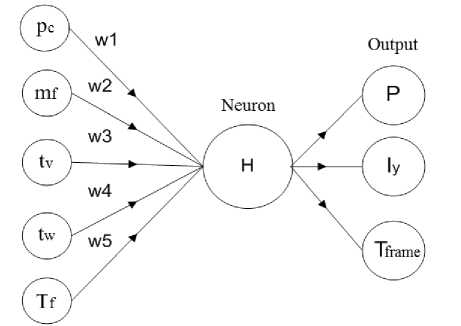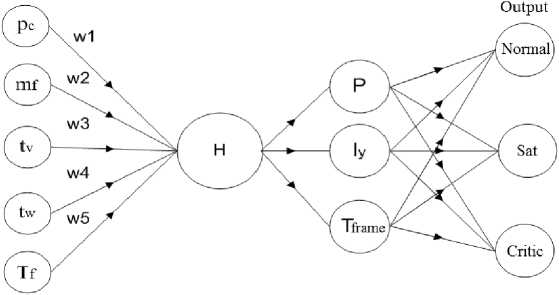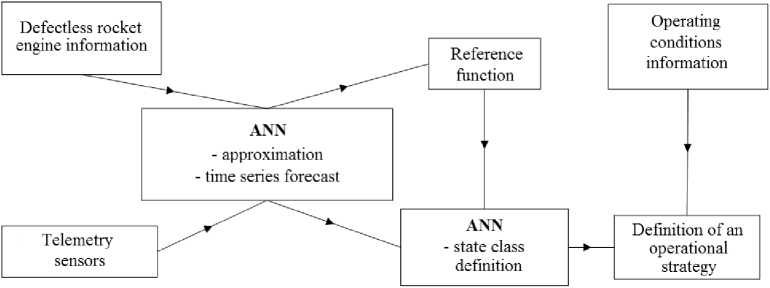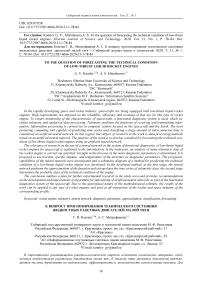To the question of forecasting the technical condition of low-thrust liquid rocket engines
Автор: Komlev G. V., Mitrofanova A. S.
Журнал: Siberian Aerospace Journal @vestnik-sibsau-en
Рубрика: Aviation and spacecraft engineering
Статья в выпуске: 1 vol.21, 2020 года.
Бесплатный доступ
In the rapidly developing space and rocket industry, spacecrafts are being equipped with low-thrust liquid rocket engines. Нigh requirements are imposed on the reliability, efficiency and economy of fuel use for this type of rocket engine. To ensure monitoring of the characteristics of spacecrafts, a functional diagnostic system is used, which includes telemetry and analytical data processing. Telemetry performs the functions of receiving and transmitting information. Information processing is carried out in computer centers located on the spacecraft and the Earth. The most promising computing tool capable of predicting time series and classifying a large amount of interconnected data is considered an artificial neural network. In this regard, the subject of research in the work is data processing methods based on an artificial neural network. The purpose of the work is to develop a method for forecasting the technical condition of low-thrust liquid rocket engines using an artificial neural network. The relevance of research on the use of a neural network in the system of functional diagnostics of low-thrust liquid rocket engines for spacecraft is explained in the introduction. In the main part, an analysis of many telemetric data of the rocket engine is carried out and their strength in the forecast of the main diagnostic parameters is determined. It is proposed to use traction, specific impulse, and temperature of the structure as diagnostic parameters. The prognostic capabilities of the neural network were investigated and a schematic diagram of a method for predicting the technical condition of a low-thrust liquid rocket engine was developed. In the developed method, at the first stage, the neural network performs the approximation of the function and extrapolates the time series of telemetric data; the second stage determines the probable class of the technical condition of the engine. The conclusion outlines a plan for further experimental research in the study area and provides recommendations on the development and improvement of algorithms for functioning of artificial neural networks as part of the functional diagnostics system of the spacecraft. Due to the generalized nature of the methodological schemes, the results of the work can be applied to any type of rocket engines and used at all enterprises of the rocket and space industry of the corresponding profile.
Rocket engine, telemetry, neural network, diagnostic parameter, approximation, classification, forecasting.
Короткий адрес: https://sciup.org/148321723
IDR: 148321723 | УДК: 629.07.058 | DOI: 10.31772/2587-6066-2020-21-1-78-84
Текст научной статьи To the question of forecasting the technical condition of low-thrust liquid rocket engines
Introduction. In the rocket and space industry, in the development of spacecrafts (SC), a significant part of the project time is occupied by the development of low-thrust liquid rocket engines (ZhRDMT). With this type of propulsion systems, the spacecraft can perform complex maneuvers in space [1; 2].
The terminology in GOST 22396–77 “Low-thrust liquid engines” defines ZhRDMT as executive bodies of a spacecraft control system with a thrust from 0.01 to 1600 N. The low-thrust liquid engines can be combined into a low-thrust liquid engine module as an assembly unit consisting of several liquid-propellant engines and at least one common element (power frame, panel, fuel supply system, thermal insulation, etc.).
The purpose of the low-thrust liquid rocket engines and their operating conditions impose on them a whole series of specific requirements and the following in particular:
– multi-mode, due to continuous operation (duration up to τ в > 103 s) and in various pulse modes with a minimum on-time of 0.03 s or less and with various pauses -from 0.03 s to several days; the pulsed mode is divided into the mode of single short switching with long pauses between switching on, the pulsed mode, when short switching is alternating with pauses of various durations, and the mode of “connected” switching with very short pauses;
-
– a large resource for the total operating time – up to 50.000 s or more;
-
– a large resource for the total number of on-time periods – up to 106;
-
– the possibility of any combination of on-time and pauses;
-
– ensuring high efficiency, specific impulse ( I sp ) of more than 2950 Ns/kg (300 s) for two-component low-
- нейросеть, диагностический параметр, аппроксима-thrust liquid engines on a self-igniting pair of “nitrogen tetraoxide (NT) and asymmetric dimethylhydrazine (ADMH)”;
– high reliability during operation – more than 10 years, which requires an acceptable thermal state, both during engine operation and during prolonged silence.
Low-thrust liquid rocket engines should have high reliability indicators, minimum weight and outer dimensions, increased resource, efficiency, stability, and minimal energy consumption. Ensuring a high level of these indicators at all stages of operation of a rocket engine requires accurate control of diagnostic parameters (DP) with subsequent prediction of the technical condition [3; 4]. For these purposes, the spacecraft is equipped with a functional diagnostic system (FDS), which allows to obtain diagnostic information about the low-thrust liquid rocket engine quickly, process data and issue a decision on the strategy for further operation.
Algorithms for monitoring DP and fault detection in FDS are based on mathematical models of work processes [5–8].
At present the development of rocket technology is impossible without telemetry on spacecraft engines. Telemetry tools collect and convert sensor signals, store and transmit information to the control center. The use of telemetry can increase the information content and completeness of tests of low-thrust liquid rocket engines, reduce the number of tests and streamline planning in the shortest possible time [9; 10].
The main tasks of diagnosing low-thrust liquid rocket engines using telemetry tools are as follows [11]:
-
– determination of the correct functioning of the engine at all possible operating modes;
-
– troubleshooting, indicating the location and possible cause of occurrence;
-
– assessment of reliability indicators;
-
– predicting the correct functioning of the engine during further operation.
Despite the great successes in the development of low-thrust liquid rocket engines and methods for diagnosing them, it is practically impossible to determine the whole set of defects, this is due to the fact that violations of the integrity of engine components and work processes can equally manifest themselves in diagnostic signs. In addition, the design and arrangement of the sensors are imperfect, as a result, when evaluating the DP there are limitations in the accuracy of the results [11], and in the case of a large set of diagnostic data, it is difficult to determine the degree of their interdependence and the degree of weight in determining the technical condition.
Nowadays these problematic issues are successfully solved by calculation methods using artificial neural networks (ANNs). This is due to the ability of ANNs to learn how to approximate functions and extrapolate, divide a lot of diagnostic data into classes and select the most informative features that carry the most complete information about the hidden laws of the state of the system. All of these operations ANN can perform in parallel with limited information [12–14].
In accordance with the abovementioned the aim of the work is to develop a method for predicting the technical condition of low-thrust liquid rocket engines using ANNs when processing telemetric data.
Selection of defining telemetry data for ANN. The spacecraft’s active life in outer space is limited by the fuel reserves on board and can be increased by increasing the efficiency of its use. Depending on the tasks performed, the low-thrust liquid rocket engines should operate continuously and in pulse modes. When operating in the pulse mode, the low-thrust liquid rocket engine must have a minimum time to reach the steady state when the engine is turned on and a minimum thrust decay time when it is turned off. The number of engine starts during operation is hundreds of thousands; therefore, the impact of fuel economy is significant. It is of great importance for engines of the control system to ensure a minimum and stable momentum value of the engine afteraction pulse. The afteraction pulse is mainly a function of the valve response time, valve volumes and the number of unreacted fuel components.
A high level of dynamic and energy characteristics of the engine will depend to a large extent on the effective organization of the liquid-phase interaction of the fuel components, which will intensify the course of the conversion of fuel into high-temperature combustion products of the engine. On the other hand, to increase the reliability of low-thrust liquid rocket engines, it is necessary to reduce thermal loads on structural elements.
In the spectrum of thrust fluctuations, the frequency characteristics of the engine can be distinguished, the change of which can be used as a sign of a violation of normal functioning. Therefore, thrust is of independent importance and should be considered as a necessary DP in assessing the correct functioning of the engine [11].
Thus, the thrust ( P ), specific impulse of thrust ( I y ) and the thermal state of the structure ( T frame ) should be used as the DP for the low-thrust liquid rocket engine [15–17].
When determining these DPs, the general telemetric data are [15]:
-
m f – mass fuel consumption, kg/s;
T f – fuel temperature, K;
-
p c – the pressure in the combustion chamber, Pa;
-
t v – valve performance, s;
-
t w – engine working time, s.
The selected factors are the most informative and carry all the information about the relationships among the DP. Therefore, the full range of telemetry tools for monitoring and transferring these characteristics to the ANN, as well as a special neural network algorithm, should be included in the FDS for the low-thrust liquid fuel engine.
Possibilities of ANN when processing telemetric data of a low-thrust liquid rocket engine . At present, more serious requirements are made to the information content of the telemetry information transmission channel from the spacecraft [18]. In modern FDS of rocket engines, DPs are divided into slowly and rapidly changing ones, the first include pressure, temperature, fuel consumption, position of the drives, the second include ripple of the propellant components, vibration and voltage of the body parts. Slowly changing diagnostic parameters are measured with a frequency from 0 to 100 Hz, rapidly changing ones are measured with a frequency from 100 to 30.000 Hz [11]. Telemetry sensors are installed based on the design features of the engine, and often they do not meet the requirements to ensure the necessary depth of diagnostics.
The transmission speed of 8 kbit/s in the telemetry channel of the spacecraft control system is considered unsatisfactory [19]. An increase in information content of the channel can be achieved by increasing the physical speed of telemetry and the frequency of the radio channel range and thus increasing high technical costs. Another solution is to compress the information before sending it to the channel.
An additional point is that there are errors in the orientation and stabilization of the spacecraft, which lead to fluctuations in the measured values, as a result the incoming telemetry information may contain lost portions of the communication session with the spacecraft.
When making diagnostic monitoring during the flight of the low-thrust liquid rocket engines, not only processed telemetry information with minimal data loss is important, but also its high-quality visualization and analysis. Decoding the recorded signal significantly reduces the control efficiency of the spacecraft; this operation takes from 15 to 20 minutes, which takes a quarter of the average orbital period of many small spacecrafts [20; 21].
The listed factors that inhibit the process of operational control of the spacecraft also include special software for processing telemetric information.
For this reason, in order to increase the speed and accuracy of real-time of telemetric data of low-thrust liquid rocket engines, it is advisable to use ANN. As already mentioned, the main advantage of ANNs over other artificial computing systems is the ability to learn, generalize and highlight hidden relationships between input and output data. ANNs make it possible to increase the reliability of the spacecraft operation due to the intelligent analysis and prediction of possible deviations of the onboard subsystem parameters from the established standard values. In the space industry, ANNs are increasingly being used in solving management, control, and diagnostic tasks [22–24].
The main functional unit of the ANN is a neuron. The synapses receive data from the sensors of the FDS into the neurons. At the output the data is converted in accordance with the settings of the neurons using various functions (fig. 1). The input of one neuron may be the outputs of other neurons. The accuracy of solving problems is determined by the number of neurons, connections and their activation properties.
To solve forecasting problems using ANNs, the function approximation approach is used. In this case, the adjustable parameters of the neural network during training take the form corresponding to some function that describes the time series of telemetry data. It should be noted that forecasting makes sense only when a previous change in diagnostic features predetermines the future value.
The forecasting process is reduced to the following sequence of stages [25–27]:
-
– preparation of initial telemetry data;
-
– training of the ANN;
-
– checking the adequacy of the ANN;
-
– description of the ANN using algebraic or logical functions with a purpose to use it further.
At the same time, the ANN can be used as a classifier of the state of a low-thrust liquid rocket engine (fig. 2). When solving the classification problem, the ANN breaks down the set of telemetry input signals, determines which class the input signal belongs to, and signals new states. It means that the neural network can identify previously unknown classes of the state of diagnosed systems, which is very important for developing new strategies for the further operation of the rocket engine.
Input

Fig. 1. ANN structure in FDS of rocket engines, where H = p k ∙ w 1 + m f ∙ w 2 + t v ∙ w 3 + t w ∙ w 4 + Т f ∙ w 6 ; w i – coupling weight; P, I y , T frame = f(Н)
Рис. 1. Структура ИНС в СФД ракетных двигателей, где Н = p k ∙ w 1 + m т ∙ w 2 + t кл ∙ w 3 + t раб ∙ w 4 + Т топ ∙ w 6 ; wi– весовой коэффициент связи; P, Iy, Tкон = f(Н)
Input

Fig. 2. Scheme of the neural network as a classifier of probabilistic states of a low-thrust liquid rocket engine
Рис. 2. Схема работы нейросети как классификатора вероятностных состояний ЖРДМТ

Fig. 3. Block diagram of a method for forecasting the technical condition of a rocket engine
Рис. 3. Блок-схема метода прогнозирования технического состояния ракетного двигателя
In this case, the ANN calculates the probability of the current state and assigns the state of the engine to one of the classes distinguished by the standards. Having processed the set of incoming data, the output neuron produces a signal corresponding to a certain class of technical condition (normal, satisfactory, critical).
Thus, the ANN can be used as a tool for calculating the value of the DP in a certain period of time and as a determinant of the current technical condition of a low-thrust liquid rocket engine.
A method for forecasting the technical condition of a low-thrust liquid rocket engine based on the ANN. The general objective of the method for forecasting the technical condition of rocket engines, using the ANN as the analytical block of the FDS, is reduced to comparing the approximated function of the current value of the DP with its reference value in appropriate operating conditions. At the same time, the tasks of extrapolating the time series of telemetric data values for a given period of time and determining the class of the engine condition are solved (fig. 3).The proposed method consists of the following steps:
-
– telemetry of the functioning of the low-thrust liquid rocket engine;
-
– a control data set training of the ANN;
-
– extrapolation of the DP value for a given period of time in the ANN;
-
– defining the class of the current state in the ANN;
-
– formation of a further operational strategy.
-
2 . The most informative features of the normal functioning of the low-thrust liquid rocket engine should include: mass fuel consumption, fuel temperature, pressure in the combustion chamber, valve performance and engine operating time. The selected features are necessary when regulating traction, specific impulse and temperature of structural elements.
-
3 . The use of the ANN to forecast the technical condition of the low-thrust liquid rocket engine, under the conditions of a minimum amount of information coming
-
4 . To verify the effectiveness of the developed method, first of all, it is required to develop a simulation model capable of generating a discrete data stream, which is telemetric information about the diagnostic features of low-thrust liquid rocket engines, and after that the ANN will be trained in forecasting and distinguishing technical condition classes. The final stage of verification should be carried out using real experimental data.
Conclusion 1. In the case of a close interrelationship of the telemetric data of diagnostic features, it is difficult to determine the degree of their weight in determining the class of the current technical condition, as well as to for-cast the further development of the functioning processes of the low-thrust liquid rocket engine.
from the sensors of the FDS, makes it possible to extrapolate time series accurately and determine the current state of the system. But the use of the ANN involves training and retraining, which imposes significant restrictions on the efficiency of control of low-thrust liquid propellant rocket engines during the flight.
Список литературы To the question of forecasting the technical condition of low-thrust liquid rocket engines
- Ageenko Ju. I., Pegin I. V. Confirmation of the energy efficiency of liquid propellant rocket engines with a deflector centrifugal mixture formation scheme. Vestnik Samarskogo gosudarstvennogo aerokosmicheskogo universiteta. 2014, No. 5, Iss. 3, P. 46–54 (In Russ.).
- Sirant A. L. Issledovanie vliyaniya neideal'nostey rabochego impul'sa zhidkostnyh raketnyh dvigateley maloy tyagi na dinamiku malogo kosmicheskogo apparata. Kand. Diss. Investigation of the effect of imperfect working impulse of liquid propulsion thruster on the dynamics of a small spacecraft. Cand. Diss. Samara, 2008, 153 p.
- Hruckij O. V. Prognozirovanie tehnicheskogo sostojanija funkcional'no-samostojatel'nyh elementov sudovoy energeticheskoy ustanovki. Kand. Diss. Prediction of the technical condition of functionally independent elements of a ship power plant. Cand. Diss.. SPb., 1996, 263 p.
- Gerasimova D. S., Savina M. G., Gejman V. N. Updating and extending aircraft technology resources]. Aktual'nye problemy aviatsii i kosmonavtiki. 2015, Vol. 1, P. 686–688 (In Russ.).
- Martirosov D. S., Kolomencev A. I. Functional diagnostics of LRE in real time]. Aviatsionnokosmicheskaya tekhnika i tekhnologiya. 2012, No. 7, P. 197–201 (In Russ.).
- Martirosov D. S., Sin'kov S. A. A method for evaluating the maximum achievable accuracy of deter mining the parameters of the elements of rocket engines in their functional diagnostics. Tr. NPO Energomash im. akad. V. P. Glushko. 2005, No. 23, P. 151–160 (In Russ.).
- Kolbaja T. Ch., Pasmurnov S. M., Jakush D. Ju. Development of technology for creating a system for diagnosing and emergency protection of liquid rocket engines. Inzhenernyy zhurnal: Nauka i innovatsii. 2016, No. 8. Available at: http://www.engjournal.ru/catalog/arse/teje/1524.html (In Russ.).
- Bondar' A. I., Pasmurnov S. M., Jakush D. Ju. Software and software for the emergency protection and control system for rocket engines and the procedure for testing it. Nauka i tehnologii. Sb. nauch. tr. RAN. 2015, Vol. 5, P. 137 (In Russ.).
- Skovoroda-Luzin V. I. Telemetriya. Glaza i ushi Glavnogo konstruktora Telemetry. Eyes and ears of the Chief Designer. Moscow, Overley Publ., 2009, 320 p.
- Polenov D. Ju. Jevoljucija telemetrii v raketnoj tehnike. The evolution of telemetry in rocket technology. Molodoy uchenyy. 2014, No. 6, P. 216–218 (In Russ.).
- Levochkin P. S., Martirosov D. S., Bukanov V. T. Problems of functional diagnostics of liquid rocket engines. Vestnik MGTU im. N. Je. Baumana. Ser. “Mashinostroenie”. 2013, No. 1, P. 72–88 (In Russ.).
- Gorban' A. N., Rossiev D. A. Neyronnye seti na personal'nom komp'yutere Neural networks on a personal computer. Novosibirsk, Nauka Publ., 1996, 276 p.
- Kruglov V. V., Borisov V. V. Iskusstvennye neyronnye seti. Teoriya i praktika Artificial neural networks. Theory and practice. Moscow, Goryachaya liniya Publ., 2002, 382 p.
- Ljubimova T. V., Gorelova A. V. The solution to the problem of forecasting using neural networks. Innovacionnaya nauka. 2015, No. 4, P. 39–43 (In Russ.).
- Kolomencev A. I., Hohlov A. N. Optimal test planning of liquid propulsion rocket engines of small thrusts to determine their main parameters and characteristics. Vestnik PNIPU. Aerokosmicheskaya tekhnika. 2016, No. 47, P. 109–122 (In Russ.).
- Dobrovol'skij M. V. Zhidkostnye raketnye dvigateli. Osnovy proektirovaniya Liquid rocket engines. Design basics. Moscow, Izd-vo MGTU im. N. Je. Baumana Publ., 2006, 488 p.
- Druzhin A. N. Teplovaya i energeticheskaya effektivnost' do i sverkhzvukovykh gazovykh zaves v raketnykh dvigatelyakh maloy tyagi. Kand. Diss. Thermal and energy efficiency before and supersonic gas curtains in small thrust rocket engines. Cand. Diss. Samara, 2002, 213 p.
- Majorova V. I., Grishko D. A., Remen' B. A., Ambarcumov A. A., Kaldarov I. S. Automation of receiving and processing backup telemetric information from space. Vestnik MGTU im. N. Je. Baumana. 2013. No. 1 (90), Р. 89–99 (In Russ.).
- Lukin F. A., Shahmatov A. V., Mushovec K. V., Zelenkov P. V. The mechanism of controlled telemetry of a spacecraft. Vestnik SibGAU. 2012, No. 5 (45), Р. 140–144 (In Russ.).
- Il'in V. A. Teleupravlenie i teleizmerenie Remote control and telemetry Moscow, Jenergoizdat Publ., 1982, 560 р.
- Milicin A. V., Samsonov V. N., Hodak V. A. et al. Otobrazhenie informacii v Centre upravleniya kosmicheskimi poletami Display of information in the Space Flight Control Center. Moscow, Radio i svyaz Publ, 1982, 192 р.
- Emel'janova Ju. G., Talalaev A. A., Fralenko V. P., Hachumov V. M. Neural network method for detecting malfunctions in space subsystems. Trudy mezhdunarodnoy konferencii “Programmnye sistemy: teorija i prilozheniya” Proceedings of the international conference “Software systems: theory and applications” (Pereslavl' Zalesskiy, Russia, may 2009). 2009, Р. 133–143 (In Russ.).
- Efimov V. V., Kozyrev G. I., Loskutov A. I. et al. Neyrokomp'yutery v kosmicheskoy tekhnike Neurocomputers in space technology. Radio engineering. Moscow, 2004, 317 р.
- Efimov V. V. Neurointellectualization of onboard control systems for spacecraft surveillance. Mehatronika, avtomatizacija, upravlenie. 2006, No. 10, Р. 2–15 (In Russ.).
- Labinskij A. Ju., Utkin O. V. To the question of approximation of a function by a neural network]. Prirodnye i tehnogennye riski (fiziko matematicheskie i prikladnye aspekty). 2016, No. 1, P. 5–11 (In Russ.).
- Rutkovskij L., Pilin'skij M., Rutkovskaja D. Neyronnye seti, geneticheskie algoritmy i nechetkie sistemy Neural networks, genetic algorithms and fuzzy systems. Moscow, Telekom Publ., 2004, 385 p.
- Tarhov D. A. Neyronnye seti kak sredstvo matematicheskogo modelirovaniya Neural networks as a means of mathematical modeling. Moscow, Radiotehnika Publ., 2006, 48 p.


